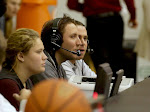Going in different directions
Well, look how that's turned out.
Siena, of course, accepted the recommendation of McCaffery and the Saints players and hired Mitch Buonaguro, who had served as McCaffery's top assistant and who, in what seems now like a previous lifetime, guided Fairfield to back-to-back NCAA tournament appearances in the 80s.
Welsh landed at Hofstra, where he signed a $700,000-per-year deal to replace Tom Pecora, who took a similar deal at Fordham.
Buonaguro is off to a flying start at Siena. After securing Trenity Burdine -- one of two highly regarded recruits who signed letters of intent last fall to play for McCaffery -- Buonaguro landed Rakeem Brookins, a scoring point guard who had previously committed to Tulane.
After the Saints missed out on Byron Allen to George Mason, they regrouped to pick up Brookins, who's rated the No. 204 high school senior in the country by Hoop Scooop. (Allen, who had drawn interest from several high-major programs, is rated No. 141).
As for Welsh?
Less than a day after Buonaguro added Brookins, the former Iona and Providence coach and ESPN broadcaster was arrested by police in Levvitown, N.Y., who found him asleep at the wheel at a green light and charged him with driving while intoxicated after his blood alcohol level registered at more than twice the legal limit.
Hofrsta officials promptly suspended Welsh without pay after the news broke.
Welsh isn't the only person with MAAC hoops ties to be charged with a recent DWI. Siena point guard Ronald Moore was booked for the same charge earlier this month, while it was revealed former Saint Kenny Hasbrouck has a DWI on his record from February, just before he left Albany to play for the Miami Heat.
Kevin Willard, who left Iona last month to take the job at Seton Hall, has a DWI on his record from his time as a Louisville assistant.
But Welsh's arrest is the most alarming of that group. Players -- especially those with NBA aspirations -- should know better. But coaches face a higher standard. And coaches who have just recently been hired after a two-year absence, face still a higher standard.
That Welsh is under fire more than five months before he holds his first practice is mind-boggling, especially given the circumstances at Hofstra. In the wake of eliminating its football program, the Pride is intent on reminding fans in the New York area that it's serious about its athletic program.
That's why it was important, after Pecora left to attempt to rebuild Fordham, that Hofstra made a splash with its next hire -- something many thought it had done by hiring Welsh.
Welsh is widely considered to be friendly, amiable and bright, among other attributes. He may well have a successful first season and a successful career at Hofstra. But there are several athletic directors throughout the region who are happy today he doesn't work for them.
 RSS
RSS

